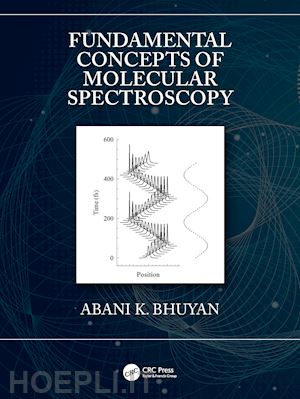Electromagnetic Wave Nature of Light Gauss’s Law of Electrostatics Gauss’s Law of Magnetism Faraday’s Law of Induced Electric Field Ampere’s Law of Induced Magnetic Field Maxwell’s Equations Wave Equation Homogeneous Travelling Plane Wave Wave Packet Reference Problems 2. Postulates of Quantum Mechanics Stern-Gerlach Experiment Postulates of Quantum Mechanics Perturbation Theory Perturbation of a Nondegenerate System Perturbation of a Degenerate State References Problems 3. Semiclassical Theory of Spectroscopic Transition Two-Level System System-Radiation Interaction Time Development of Eigenstate Probabilities Probability Expressions Rabi Oscillations Transition Probability and Absorption Coefficient Limitations of the Theory Collisional Line Broadening Line Broadening from Excited State Lifetime Spectral Line Shape and Line Width Homogeneous or Lorentzian Line Shape Inhomogeneous or Gaussian Line Shape Doppler Interpretation of Inhomogeneous Line Shape General Reading Problems 4. Hydrogen Atom Spectra Free Hydrogen Atom Eigenvalues, Quantum Numbers, Spectra, and Selection Rules Hydrogen Atom in External Magnetic Field: Zeeman Effect and Spectral Multiplets Magnetic Moment in External Magnetic Field Larmor Precession Eigenstate, Operator, and Eigenvalue in External Magnetic Field Anomalous Zeeman Effect and Further Splitting of Spectra Electron Spin and Spin Magnetic Moment Lande -factor Spin-Orbit Coupling Spin-Orbit Coupling Energy Spectroscopic Notation Fine Structure of Atomic Spectra Splitting of Degeneracy: Anomalous Zeeman Effect Zeeman Effect in Weak Magnetic Field Zeeman Splitting Changeover from Weak to Strong Magnetic Field Electron-Nuclear Hyperfine Interaction Zeeman Splitting of Hyperfine Energy Levels Zeeman Splitting of Hyperfine States in Weak Magnetic Field Hyperfine States of Hydrogen Atom in Strong Magnetic Field Stark Effect Hydrogen Atom in External Electric Field Effect on the Level Effect on the Level References and Text Problems 5. Molecular Eigenstates Born-Oppenheimer Approximation Solution of the Total Schrödinger Equation States of Nuclear Motion Adiabatic and Non-Adiabatic Processes Molecular Potential Energy States One-Electron Hydrogen-Like Atom States Molecular Electronic States Derived from Atom States LCAO-MO Molecular Eigenstates of H2+ Molecular Eigenstates of H2 Singlet and Triplet Excited States of H2 Electric Dipole Transition in H2 Molecular Orbital Energy and Electronic Configuration Molecular Orbitals of Heteronuclear Diatomic Molecule Molecular Orbitals of Large Systems LCAO-MO of Porphyrins Free-Electron Orbitals of Porphyrin References Problems 6. Elementary Group Theory Symmetry Operations Rotation Reflection Improper Rotation Inversion Point Group Properties of Point Groups Representation of Symmetry Operators of a Group Group Representations Labels of Irreducible Representations Reduction of Representations to Irreducible Representations Direct Product of Irreducible Representations Applications Energy Eigenvalues of Molecular Orbitals Removal of Energy Degeneracy by Perturbation General Selection Rules for Electronic Transitions Specific Transition Rules References Problems 7. Rotational Spectra Rotational Spectra of Diatomic Molecules Schrödinger Equation for Diatomic Rotation Rotational Energy of Rigid Rotor Rotational Energy of Non-Rigid Rotor Stationary State Eigenfunctions and Rotational Transitions Energy Levels and Representation of Pure Rotational Spectra Rotational Spectra of Polyatomic Molecules Rotational Inertia Energy of Rigid Rotors Wavefunctions of Symmetric Tops Commutation of Rotational Angular Momentum Operators Eigenvalues for Tops Selection Rules for Polyatomic Rotational Transition General Reading Problems 8. Diatomic Vibrations, Energy, and Spectra Classical Description of an Oscillator Schrödinger Equation for Nuclear Vibration Selection Rules for Vibrational Transitions Rotational-Vibrational Combined Structure General Reading Problems 9. Polyatomic Vibrations and Spectra A Simple Classical Model to Define a Normal Mode Vibrational Energy from Classical Mechanics Solution of Lagrange’s Equation Vibrational Hamiltonian and Wavefunction Symmetry of Normal Modes Finding the Vibrational Frequencies Activity of Normal Modes of Vibration Secondary Band Manifold in Infrared Spectra Overtone Band Hot Band Combination Band Fermi Resonance Band Vibrational Angular Momentum and Coriolis-Perturbed Band Structure Rotational Band Structure in Vibrational Bands Selection Rules for Vibrational Transition References Problems 10. Raman Spectroscopy Light Scattering Frequencies of Rayleigh and Raman-Scattered Light Limitation of the Classical Theory of Raman Scattering Brillouin Scattering Raman Tensor Polarizability Tensor Ellipsoid Nomenclature of the Polarizability Tensor Anisotropy of Polarizability Isotropic Average of Scattered Intensity Semi-Classical Theory of Raman Scattering Rotational Raman Spectra Vibration-Rotation Raman Spectra Raman Tensor and Vibrational Symmetry Secondary or Coupled Bands in Raman Spectra Solution Phase Raman Scattering Resonance Raman Scattering Sundries and Outlook References Problems 11. Electronic Spectra Energy Term-Value Formulas for Molecular States Dipole Transitions in the Electronic-Vibrational-Rotational Spectra Electronic Transition Dipole with Nuclear Configurations Franck-Condon Factor Progression of Vibrational Absorption in an Electronic Band Analysis of Vibrational Bands Analysis Rotational Bands Electron-Nuclear Rotational Coupling and Splitting of Rotational Energy Levels Hund’s Cases -type Doubling Selection Rules for Electronic Transitions in Diatomic Molecules Symmetry-Based General Rules for Electronic Transitions Selection Rules Selection Rules Pertaining to Hund’s Coupling Cases Perturbation Manifests in Vibronic Spectra Rotational Perturbation and Kronig’s Selection Rules Frequency Shift and -doubling in Rotational Perturbation Vibrational Perturbation Predissociation Diffused Molecular Spectra Stark Effect in Rotational Transitions: Observation and Selection Rules Zeeman Effect on Rotational Energy Levels and Selection Rules Magnetooptic Rotational Effect References Problems 12. Vibrational and Rotational Coherence Spectroscopy Ultrashort Time of Spectroscopy Wave Packet Coherence Linear Superposition and Interference Vibrational Coherence Rotational Coherence Coherence Decay Wave Packet Oscillation Frequency Spectrum of Time-Domain Coherence Assignment of Vibrational Bands Pure Rotational Coherence Density Operator, Coherence, and Coherence Transfer Homogeneous and Statistical Mixture of States of a System Density Operator Time Evolution of the Density Operator Matrix Representation of the Unitary Transformation Superoperator Matrix Representation of the Commutator Superoperator Partial Density Matrix Density Operator Expression Using Irreducible Tensor Operator Density Matrix Treatment of an Optical Experiment References Problems 13. Nuclear Magnetic Resonance Spectroscopy Nuclear Spin of Different Elements Excited-State Nuclear Spin Nuclear Spin Angular Momentum and Magnetic Moment Zeeman Splitting of Nuclear Energy Levels Larmor Precession of Angular Momentum Transition Torque Mechanics Spin Population and NMR Transition Static Field Dependence of Signal Intensity Nuclear Receptivity Macroscopic Magnetization Bloch Equations and Relaxation Times The Rotating Frame Bloch Equations in the Rotating Frame RF Pulse and Signal Generation Origin of Chemical Shift: Local Shielding Long-Range Shielding Ring Current Effect, Electric Field Effect, Bond Magnetic Anisotropy, Shielding by Hydrogen Bonding, Hyperfine Shielding, Shielding from Solvent Effect, Chemical Shift Scale Spin-Spin Coupling Basic Theory of the Origin of Nuclear Spin Relaxation Mechanism of Spin Relaxation Shielding Anisotropy Spin-Rotation Interaction Scalar Interaction Paramagnetic Effect Dipole-Dipole Interaction Dipolar Interaction and Cross Relaxation Effect of Dipo











